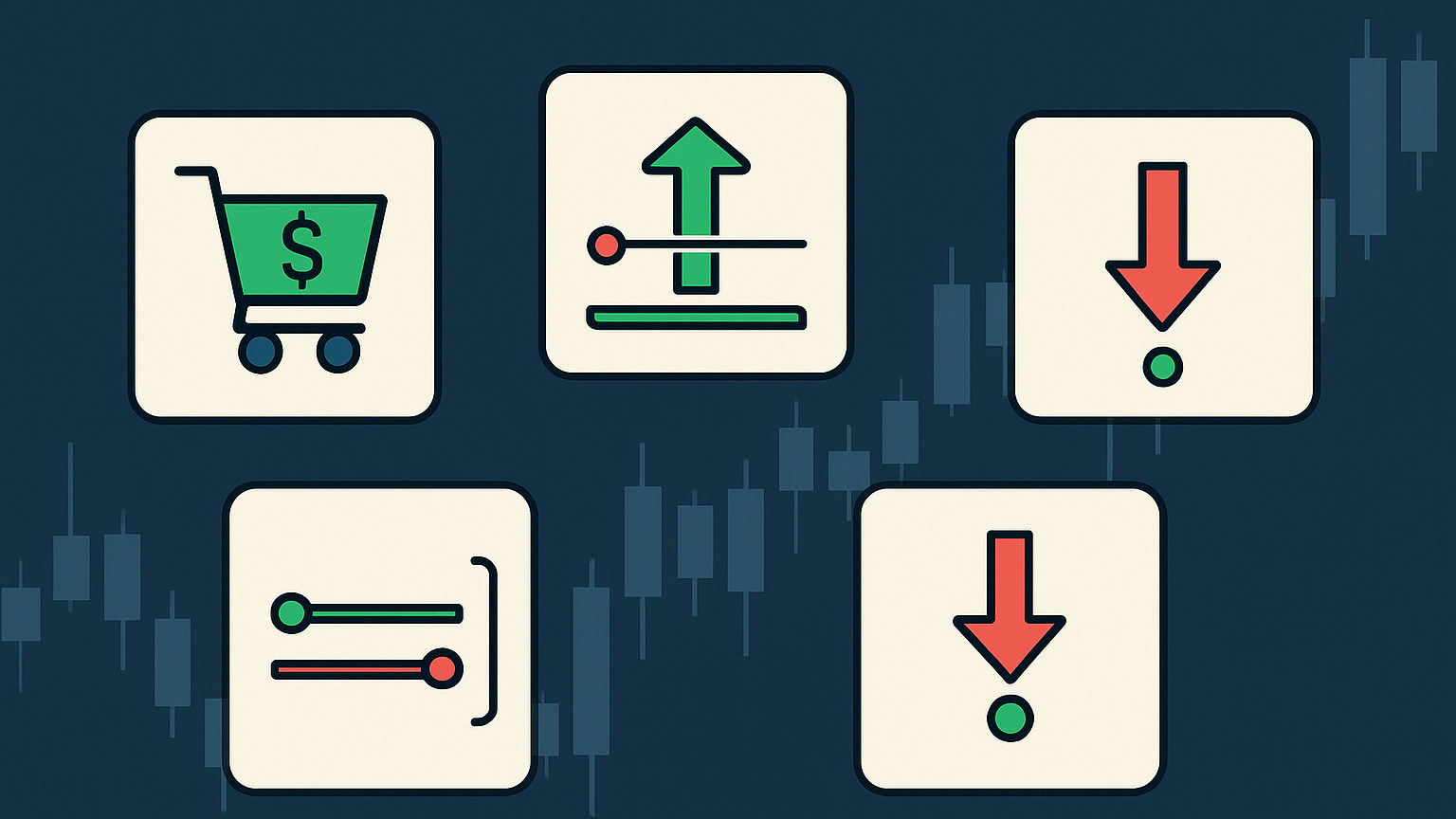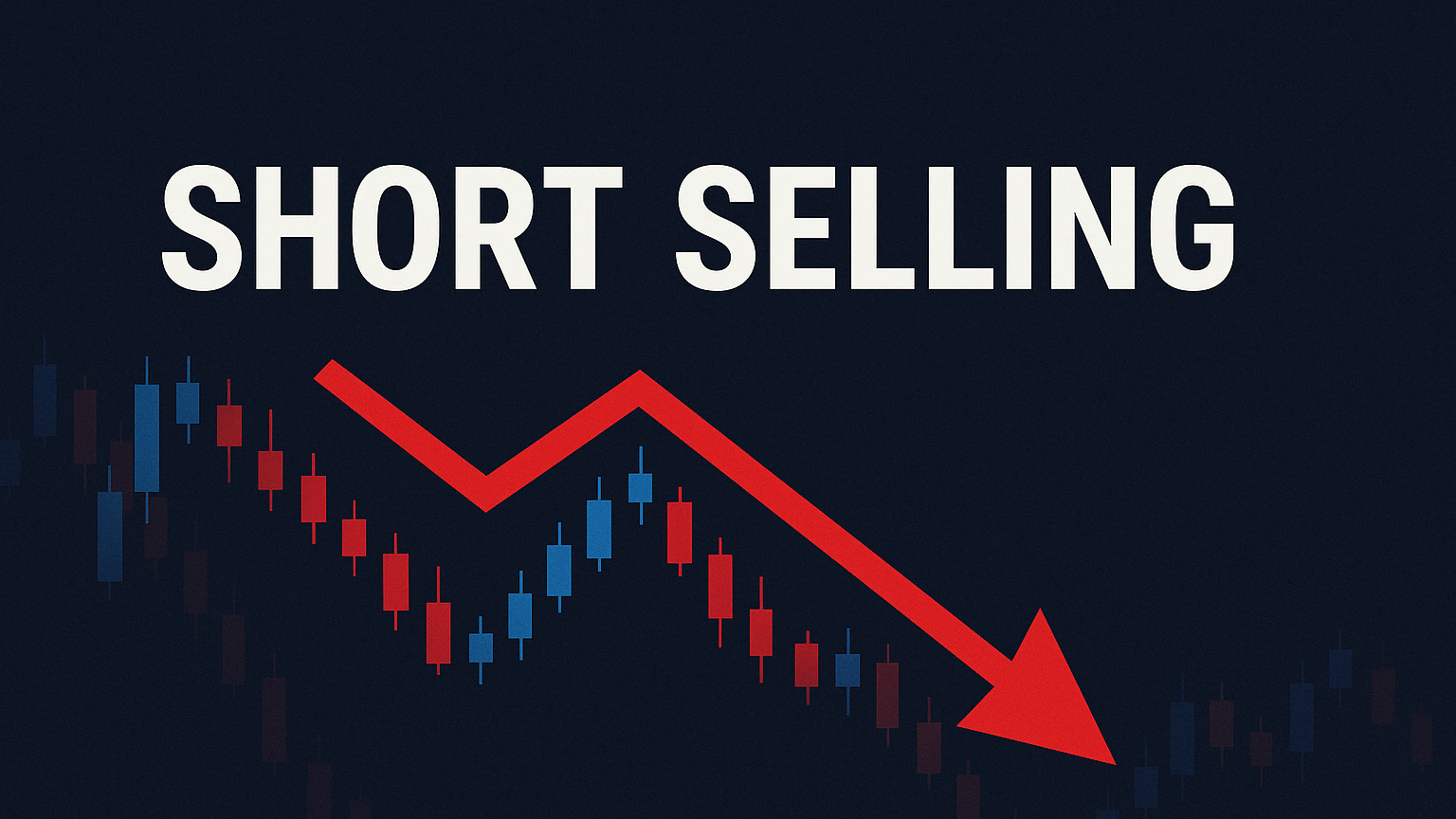Master the basics of trading order types to enhance your strategy and manage risk effectively in various market conditions.
The type of trading order you use can make or break your strategy. Whether you're aiming for speed, price control, or risk management, knowing the right order type is essential. Here's a quick breakdown to get you started:
- Market Orders: Fast execution at current prices, ideal for liquid assets but risky in volatile markets.
- Limit Orders: Control the price of your trade but risk not being executed.
- Stop Orders: Automate trades to minimize losses or lock in profits via stop-loss, buy-stop, or the LuxAlgo Library’s Fibonacci Trailing Stop indicator.
- Special Orders: Add flexibility with time-based (e.g., Day, GTC) or volume-based (e.g., Iceberg, AON) conditions.
Quick Comparison
| Order Type | Key Benefit | Best For |
|---|---|---|
| Market Orders | Quick execution | Large-cap stocks, ETFs |
| Limit Orders | Price control | Volatile or illiquid assets |
| Stop Orders | Risk management | Protecting profits, limiting losses |
| Special Orders | Flexibility | Large trades, specific timing |
Start simple: use market orders for speed, limit orders for precision, and stop orders for risk control. Combine them as you gain experience to refine your trading strategy.
Trading Order Types: Market Order - Buy Limit - Sell Limit - Buy Stop - Sell Stop
Market Orders
Market orders are a basic yet crucial element in trading, designed to ensure quick execution at the current market price.
What Is a Market Order?
A market order instructs your broker to buy or sell an asset immediately at the best available price. It prioritizes speed over price precision, making it ideal for assets with high liquidity.
Pros and Cons of Market Orders
Knowing the advantages and limitations of market orders can help you make better trading choices:
| Aspect | Pros | Cons |
|---|---|---|
| Execution | Quick and immediate | No control over the exact price |
| Simplicity | Easy to use | Limited flexibility in price management |
| Best For | Large-cap stocks, ETFs | Not ideal for volatile or illiquid stocks |
| Price Impact | Minimal in liquid markets | Prone to slippage in thinly traded markets |
| Trade Volume | Works well for small trades | Large trades can disrupt market prices |
When and How to Use Market Orders
Market orders work best when speed is more important than locking in a specific price. Here are some tips to use them effectively:
- Focus on highly liquid assets with narrow bid-ask spreads.
- Place small trades that won't significantly affect prices.
- Use them for large-cap stocks or major ETFs.
- Always check bid-ask spreads to avoid unexpected price swings.
- Avoid using market orders during low-liquidity times, like pre-market or after-hours sessions, when price volatility is higher.
- For volatile or less liquid assets, consider limit orders for better price control.
While market orders ensure your trade is executed (unless halted), the final price may differ from the quoted market price. They're a great option for investors looking to quickly establish positions in stable, frequently traded securities. This sets the stage for comparing other order types in the next sections.
Limit Orders
Limit Order Basics
Limit orders allow you to set a specific price at which you're willing to buy or sell. A buy limit order ensures you only purchase at your chosen price or lower, while a sell limit order ensures you sell at your price or higher. This gives you control over the price but doesn’t guarantee the order will be executed. Essentially, limit orders prioritize hitting your price target over completing the transaction quickly.
Limit Order Pros and Cons
Let’s break down the upsides and downsides of using limit orders:
| Aspect | Advantages | Disadvantages |
|---|---|---|
| Price Control | Ensures execution at your set price | No guarantee the order will fill |
| Risk Management | Shields against sudden price swings | May miss out on market moves |
| Cost Efficiency | Helps manage trading expenses | Could result in only partial fills |
| Best Usage | Works well for volatile or low-volume stocks | Not ideal when speed is crucial |
When to Use Limit Orders
Limit orders are particularly helpful in certain scenarios:
-
Volatile Markets
When markets are unpredictable, limit orders help you avoid overpaying or underselling during sharp price swings. They're a smart choice for stocks that see big intraday price changes. -
Illiquid Securities
For stocks with low trading volume, limit orders ensure you don’t pay more than intended or sell for less than planned. This is especially important when dealing with large positions. -
Strategic Price Targets
Suppose XYZ stock is trading at $9.80, but you want to buy at $9.50. A buy limit order at $9.50 ensures you’ll only purchase if the price drops to your target. If the price stays above $9.50, the order won’t execute.
To make the most of limit orders, consider these tips:
- Set realistic price targets based on market trends.
- Keep an eye on your orders, especially in fast-moving markets.
- Factor in liquidity when deciding how much to trade.
- Be prepared for partial fills and adjust accordingly.
- Update your limit prices as market conditions shift.
Stop Orders
Stop orders, like market and limit orders, help traders execute trades while managing risk effectively.
Stop Order Categories
Stop orders are designed to limit losses or secure entry by triggering a market order when specific conditions are met. Here’s a breakdown of the main types:
| Stop Order Type | Purpose | Ideal For |
|---|---|---|
| Stop-Loss Order | Sells a position at market price when the stop price is hit | Minimizing losses in a declining market |
| Buy-Stop Order | Buys a position when the price reaches a certain level | Entering trades during upward trends |
| Stop-Limit Order | Combines a stop trigger with a limit order to set a specific price | Controlling the price of execution |
| LuxAlgo Library’s Volume Delta Trailing Stop indicator | Adjusts the stop price as the market moves favorably | Locking in profits while allowing for further gains |
Stop Order Examples
- Stop-Loss Example: Imagine owning a stock priced at $27. Setting a stop-loss at $25 ensures your loss is capped at $2 per share if the price drops.
- Breakout Strategy: If a stock trades between $27 and $32, placing a buy-stop order at $32.25 allows you to enter the trade as soon as the price breaks above resistance.
Next, let’s explore some practical tips for using stop orders in different market scenarios.
Stop Order Guidelines
To get the most out of stop orders, consider these practical tips:
- Position Sizing and Stops: In volatile markets, use smaller positions combined with wider stops to reduce the risk of being stopped out prematurely.
- Price Gaps: Be aware that price gaps can cause stop orders to execute at prices different from your set stop level.
- Adapting to Market Conditions:
- Set shorter-term profit targets.
- Engage trailing stops earlier to secure gains.
- Use percentage-based stops that align with typical daily price movements.
Important: Some major exchanges no longer accept certain stop orders due to the risks involved.
Special Order Types
Special orders go beyond the basics, offering strategies tailored to specific market conditions. They allow for precise timing, controlled execution, and reduced market impact—key advantages for traders navigating different scenarios.
Time-Based Orders
Time-based orders are designed with specific expiration rules, making them suitable for various trading objectives:
| Order Type | Function | Best Used For |
|---|---|---|
| Day Orders | Expires at market close | Routine trading activities |
| Good 'Til Canceled (GTC) | Stays active until filled or canceled | Building long-term positions |
| Immediate Or Cancel (IOC) | Executes immediately or cancels | Fast-moving markets |
| Fill Or Kill (FOK) | Completes fully or cancels instantly | All-or-nothing execution |
Charles Schwab’s guide to trading orders showed that 85% of their clients preferred Day orders, while GTC orders had an average holding period of 65 days, compared to just 2 days for Day orders.
Volume-Based Orders
Volume-based orders are essential for minimizing market impact when handling large trades. Here are two key types:
"Iceberg orders are designed to conceal large trades by splitting them into smaller, more manageable portions... allowing traders to avoid signaling their intentions to the market." – Matthias Hossp
- Iceberg Orders: These break up large trades into smaller, visible portions. As one portion fills, the next becomes visible, helping avoid price disruptions while executing significant positions.
-
All or None (AON) Orders: These orders require full execution of the entire position or no execution at all. They are especially useful for:
- Trading low-volume securities
- Executing specific hedging strategies
- Precisely managing position sizes
Special Order Applications
Here’s how special orders can be applied in different market conditions:
High-Volatility Markets:
- Use IOC orders for quick execution.
- Leverage iceberg orders to enter large positions discreetly.
- Apply FOK orders for all-or-nothing trades.
Low-Liquidity Environments:
- Opt for AON orders to ensure complete fills.
- Use GTC orders for gradual position building.
- Choose time-based orders during specific trading hours.
For the best results, combine these special orders with standard limit and stop orders. This gives you greater control over both execution timing and price levels.
Note: Brokers may implement these order types differently. Always check with your broker to understand their specific features.
Selecting Order Types
Choosing the right order type is a key part of any trading strategy. According to FINRA, understanding how to effectively select and use order types can improve your trading outcomes significantly.
Selection Criteria
To decide which order type fits your needs, consider both market conditions and your trading goals. These factors can directly impact how well your orders perform:
| Market Condition | Recommended Order Type | Primary Benefit |
|---|---|---|
| High Volatility | Stop-Loss Orders | Helps protect against sudden price swings |
| Low Liquidity | Limit Orders | Provides better price control and certainty |
| Fast-Moving Markets | Market Orders | Ensures the order gets executed quickly |
| Range-Bound Markets | Limit Orders + Stop Orders | Balances entry and exit price optimization |
"It helps to think of each order type as a distinct purpose-built method." – Charles Schwab
For instance, market orders are often chosen for their speed, while limit orders are ideal when you want to target a specific price.
Common Order Type Mistakes
Even with clear guidelines, traders can make mistakes when selecting order types. A report by IG Group revealed that 35.3% of active non-discretionary trading accounts were unprofitable in Q2 2024.
Here are some pitfalls to watch out for:
- Misusing Market Orders: Using market orders during volatile periods can lead to slippage. Limit orders are better for controlling prices in such cases.
- Improper Stop‑Loss Settings: Adjust stop‑loss levels based on the asset's average daily range to avoid premature exits.
- Overcomplicating Strategies: Stick to basic order types when you're starting out. Add more advanced orders as you gain experience.
Order Placement Tips
To get the most out of your orders, keep these tips in mind:
- Balance Price Control and Speed: For stocks with low liquidity, limit orders are a better choice for maintaining price control.
- Incorporate Risk Management: Use stop‑loss orders consistently. Kenneth Fisher from OANDA highlights the importance of timing your exits:
"When we start winning, we get anxious about losing our gains. We close trades prematurely to capture the profit before the price starts to drop again. We should be holding on to it and closing out just as it turns, which would maximize the profit."
- Understand Your Broker's Policies: Check your broker's order types, fees, and execution practices to avoid surprises.
Conclusion
Summary
Understanding the different order types is crucial for effective trading. It helps you balance between how quickly your trades are executed and how much control you have over the price. Here's a quick breakdown:
| Order Type | Main Benefit | Ideal Scenario |
|---|---|---|
| Market Orders | Ensures Execution | When you need quick entry/exit |
| Limit Orders | Controls Price | When targeting a specific price |
| Stop Orders | Manages Risk | For protecting profits or limiting losses |
| Time‑Based Orders | Controls Duration | For managing longer‑term positions |
These basics provide a foundation for putting them into practice.
Implementation Steps
Here’s how you can put this knowledge to use:
- Start Simple: Use a demo account to practice with market and limit orders. This lets you get comfortable with order execution without risking real money.
- Develop a System: Combine different order types, like market and limit orders, to match your strategy and handle risk effectively.
- Prioritize Risk Management: Include stop‑loss orders in your trading plan to protect against losses. Check with your broker on fees, execution policies, and tax considerations to avoid surprises.
"Depending on your investing style, different types of orders are better for trading stocks." – Investopedia
Keep in mind that successful trading requires ongoing adjustments. Your order types should align with your goals and adapt as market conditions change. By integrating these steps into your overall strategy, you can improve your trading results.







